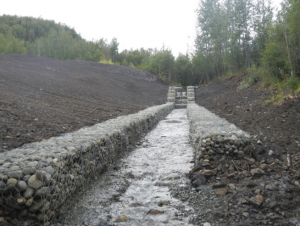
Crews are sampling water and sediments this summer near the site of the old Red Devil mercury mine in the middle Kuskokwim. It’s work that comes in advance of a large clean up project.
Work has been underway for years to study how to clean up the abandoned mine. And there’s still more to learn. Mike McCrum is Project manager for the Red Devil project with BLM in Anchorage.
“We still had unanswered questions with regard to tailings that have made their way into the Kuskokwim River. We also had unanswered questions for groundwater on the mine site,” said McCrum.
Researchers are putting in monitoring wells at the site and soon will sample sediments in the Kuskokwim.
The clean up work is split into two big phases now as leaders finalize a feasibility study for cleaning up the quarter million cubic yards of tailings that have been leaking mercury, arsenic, and antimony into the Kuskokwim river for years. It’s leading up to a multi-million dollar project to stop the tailings from releasing hazardous metals.
“In the end the most important thing is to address the tailings. They’re still piled up next to Red Devil creek, and that’s not a good place for them to be. The issues we’re working on now are not whether we’re going to do anything. The issues are more: what are we going to do, what’s the most efficient and optimal thing to do,” said McCrum.
Last summer they completed some work re-grading tailings piles so they were not so steep, excavating a new channel, and creating an area of still water in which sediments could drop out before reaching the Kuskokwim River. The options under consideration now include simply fencing off the site, or digging up the tailings.
“To do a pretty extensive excavation in the Red Devil Creek valley. Removing virtually all of the tailings that are there, removing the soil that’s been impacted by the tailings, scraping off the top of the barge landing and placing that material in a repository on the north side of the site that at a higher elevation and and away from surface water. We would cap that with a very low permeability cap,” said McCrum.
Keeping water out would stop leaching. The final and most expensive option, by far, would be to actually barge out the material and take it to a hazardous waste facility in Northern Oregon. The barging alternative would involve 123 barge transits and cost $285 million. Keeping the material on site would cost $35 million.
“It’s common to simply remove them from the location where they’re creating an environmental issue. In this case it’s being near the water, it’s the aquatic ecosystem that’s the most sensitive to the metals being released by the tailings. So, getting those tailings up and away from the water is probably the single most important thing you can do,” said McCrum.
The BLM plans to take a proposed plan out to Kuskokwim communities early in 2016. A final decision is expected next year and the agency hopes to complete the work within the next few years. The sediment work would come later.
The Red Devil mercury mine operated from 1933 to 1971. By the 1980s it was considered abandoned and the government began the long process of cleaning up. Studies have found buildup of metals in fish nearby. The State has issued a warning to residents not to collect subsistence foods nearby.
They also warned pregnant women and young children to avoid large-sized pike and lush. Those are predators that can accumulate mercury over many years.
Ben Matheson is a contributor with the Alaska Public Radio Network.




